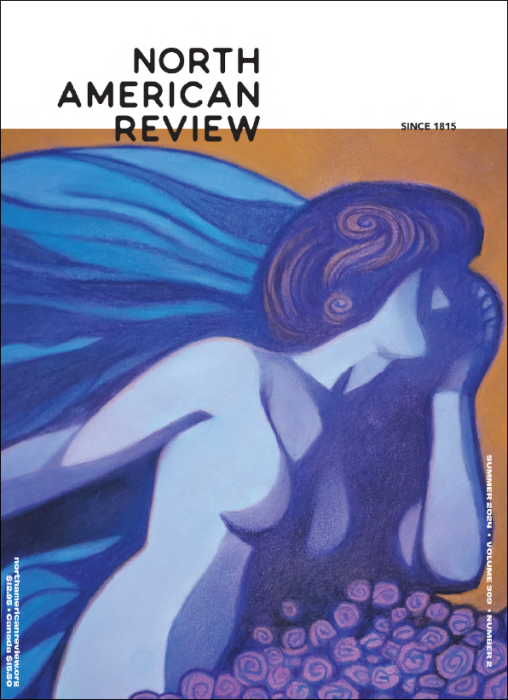309.2 Summer 2024

Buy this Issue
Never miss
a thing.
Subscribe
today.
We publish all
forms of creativity.
We like stories that start quickly
and have a strong narrative.
We appreciate when an essay
moves beyond the personal to
tell us something new about
the world.
Subscribe
FROM THE EDITORS
And in the midst of this wide quietness
A rosy sanctuary will I dress
With the wreath’d trellis of a working brain.
John Keats, “Ode to Psyche”
Famously, the epitaph on Keats’s gravestone reads, “Here lies One Whose Name was writ in Water.” In one sense, the young English poet has been proven— decidedly, lyrically, ironically—wrong. His name was etched instead into the Stone of History. Oscar Wilde promised, “it shall stand.” Indeed it has. In another sense, Keats got it right. All of our names will evaporate in due time (pun intended). More perplexing than posterity, however, is the waterwrit mind in life, struggling to hold onto one’s own name, much less others: words, memory, identity itself eddying away, slipping downstream.
Tens of millions of people worldwide suffer from dementia, including our featured artist, Walter Kravitz, whose charcoal drawings aptly demonstrate Keats’s “negative capability,” dwelling in “uncertainties, mysteries, doubts” without resorting to logic or reason, representation or explanation to reconcile ambiguity. His art is a hypostatic union of fluid and solid: fully water, fully stone. His wife Judith Harris, whose beautifully sad American poems grace the final page of this issue, describes Kravitz’s interest in “the paradox” of “turning water into stone, and stone into water.” Working with (and living in) paradox isn’t easy. Harris suggests that her husband’s recent work functions as a container for what memory remains. The “working brain” in Keats’s “Ode to Psyche,” quoted above, is as a similar container. The temple he builds to worship the goddess becomes a metonymy for poetry itself. Kravitz’s drawings serve to frame himself and form an identity that can survive the confusion of memory, of “present in the past, or past in the present.”
In the ancient Platonic conception, memory was figured as a wax tablet into which our experiences, perceptions, and observations are pressed. Over time each impression may dull or fade, but it starts out as a solid thing: more stone than water. We intuit the metaphor: our brain as a vessel holding each individual event from our past. Memories get older, but they’re still in there somewhere. Eventually, we’ve come to think of memory and the brain with more nuance. In his essay “Illusions of Memory” in the May 1884 issue of the North American Review, Henry F. Osborn analyzes the phenomenon of false memories:
Physiologically speaking, the memory of an event is a revival, a repetition of the original brain changes accompanying that event; it is not on record in a single cell, as was formerly believed, but in a group. From the psychical stand-point, also, memory is the revival of an association of ideas, it being impossible to revive an idea isolated from others.
Rather than a “record in a single cell,” we now understand memory as “an association of ideas.” We can’t retrieve a memory like a piece of jewelry from a box. We must reconstruct it every time, stringing together a cluster of beads and then reviving that memory by wearing it around our necks. If who we are is what we recall, this constant reconstructive process tells us that we are formed and reformed all the time. We are creatures of our own imaginations: aesthetic, writ in water, objets de art. We are real pieces of work.
This issue of NAR offers an abundance of real pieces of work: poems, essays, stories, and visual art that delve dauntlessly into negative capability and the complexities of the human brain. E. R. Ramzipoor imagines a future of “stepping into someone else’s memories” in “Conversation with Gertrude, Age Twenty.” Natalie Southworth’s “Rules for Sanity” follows a girl navigating a household haunted by the specter of a mentally unwell mother sinking deeper into delusion. Latifa Ayad’s lush and eerie story “Water, Mud, Ink, Blood” presents a couple falling in love, getting married, and dealing with addiction. In the startlingly-believable world of Jason Fernandes’s “Lovesick,” selected by Allegra Hyde as the winner of this year’s Kurt Vonnegut Speculative Fiction Prize, couples take pills to remain in love, raising fundamental questions about the nature of loyalty and connection, self and other.
Paul Crenshaw’s essay “Prescribed” looks at the proliferation of other kinds of pills, the problem of chronic pain, and the aftermath of drug addiction. False, faulty, or failing memory is a theme in Lane Chasek’s “A Pallet of Yellow Bricks” and Gregory Martin’s “The Mercy of Strangers,” and in “Reflections and the Multiple Layers that Intercede,” Lilly U. Nguyen connects the artwork of Robert Bechtle (painted in the “mood of memory”) to her own father’s memories of Vietnam. Steve Mitchel’s “The Magician of the Temporal Lobe” narrates with humor and pathos what happens to the brain during a series of focal seizures.
You will find “signals / of fauna bodies in the brain” in Radha Marcum’s poem “Equinox,” and the “brain’s electricity blinks” in Helena Feder’s “Ecstatic Truth.” We’re also pleased to present “Ostinato, 1981,” a new poem by the judge of our upcoming James Hearst Poetry Prize, Stephanie Burt. In music, an ostinato is a brief musical phrase repeated throughout a composition. Burt plays hers in the key of memory, flickers and snippets returning, rising to the surface from the past, where it had been writ in water. ⬤



